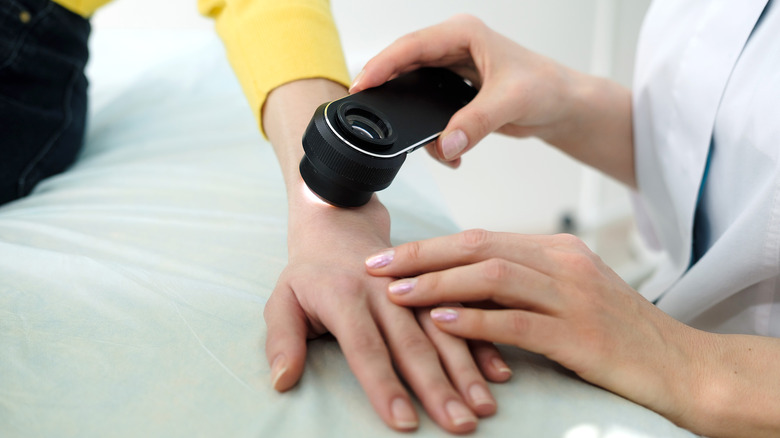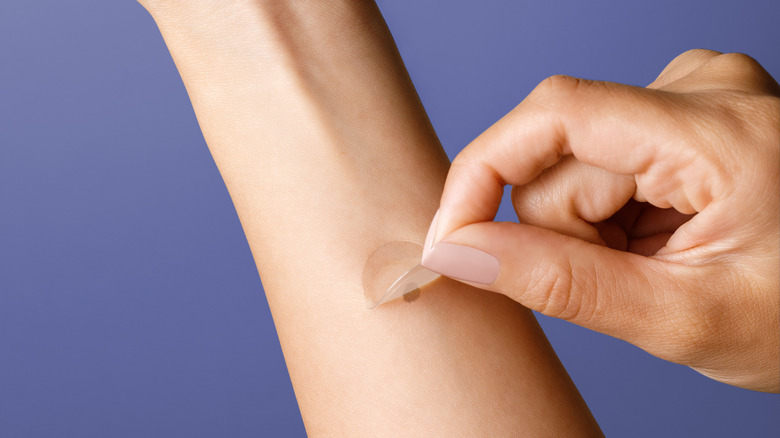Dr. John Dobak Explains Why Regular Skin Checkups Are Essential For Melanoma Diagnosis - Exclusive
Many of us have elaborate daily skincare routines that keep our skin healthy and looking great. But are we also scheduling regular skin checkups with our primary care doctors or a dermatologist? According to Dr. John Dobak, the founder of the biotech company DermTech, we should all be getting our skin checked out by a medical professional at least once a year to provide doctors the opportunity to look for signs of skin cancer, including melanoma.
According to Dr. Dobak, when it's detected early, melanoma has one of the highest survival rates of any form of cancer. However, if it's missed and allowed to progress, it can easily spread to other organ systems. Once it does, the survival rate for melanoma drops to just 27%. So even if we don't have any reason to be concerned about our skin, we still need to schedule those yearly checkups, just to make sure issues can be identified as quickly as possible.
In an exclusive interview with Health Digest, Dr. Dobak talked about what to expect at a yearly skin checkup, the warning signs for melanoma, and how it's traditionally diagnosed.
Your yearly skin checkup
Dr. John Dobak stressed that a medical professional's discerning eyes are the only way to be sure that none of your moles, skin tags, or skin discolorations are normal. Even if we think that a mole looks normal, we're not trained to know what to look for — but the professionals are. He added that doctors are able to examine parts of people's bodies that they can't get a good look at, like their backs. During that appointment, your doctor will do a general examination of your skin, and then hone in on anything that looks suspicious.
"Doctors will visually assess a mole using a few different tactics. They may use the 'ABCDE' criteria or the 'Ugly Duckling' warning sign, which refers to identifying the most unique mole on a patient's body relative to their other moles," explained Dr. Dobak. "They may also use a dermatoscope, which acts as a magnifying glass to help doctors take a closer look at any concerning moles."
Ultimately, it's up to your doctor's professional opinion on whether something looks concerning. If they decide something about your skin warrants further examination, they may suggest further diagnostic measures.
Diagnosing melanoma
Doctors use a few strategies to assess which moles, skin tags, or skin discolorations might need further assessment. The biggest things they're looking for are the early signs of melanoma.
"The 'ABCDE' criteria provides a good framework for determining if a mole should cause concern," Dr. Dobak explained. "'A,' does the mole have asymmetry? 'B,' are the borders irregular? 'C,' have you seen any changes in the mole's color? 'D,' is the diameter bigger than about the head of a pencil eraser? And 'E,' is the mole evolving? The last piece is possibly the most important, as moles that change over time should be monitored closely."
If a feature on your skin meets any of these criteria, your doctor may recommend a biopsy. Your doctor might also use a new diagnostic tool called a Smart Sticker, developed by Dr. Dobak's company DermTech. The Smart Sticker is applied, then peeled off, collecting a skin sample in the process. That sticker is sent to the DermTech lab for special testing based on the human genome that gives clues about skin cancer earlier than regular testing.
If that test comes back positive for early warning signs, your doctor will likely do a biopsy. If it comes back negative, you've avoided a biopsy and you're in the clear until your next skin checkup. Just remember to schedule it for the next year!
To learn more, visit dermtech.com.



